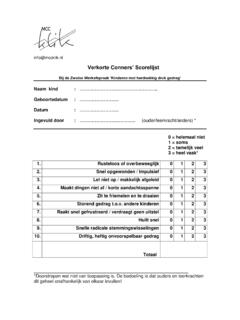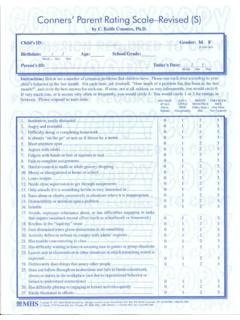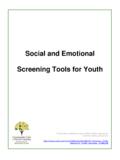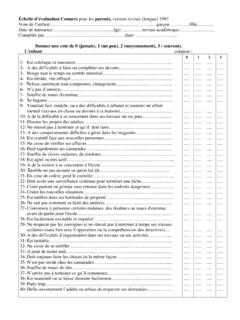Transcription of The SNAP-IV Teacher and Parent Rating Scale
1 The SNAP-IV Teacher and Parent Rating Scale James M. Swanson, , University of California, Irvine, CA 92715. Name:_____ Gender:_____ Age:_____ Grade:_____. Ethnicity (circle one which best applies): African-American Asian Caucasian Hispanic Other_____. Completed by:_____ Type of Class:_____ Class size:_____. For each item, check the column which best describes this child: Not At Just A Quite Very All Little A Bit Much 1. Often fails to give close attention to details or makes careless mistakes in schoolwork or tasks _____ _____ _____ _____. 2. Often has difficulty sustaining attention in tasks or play activities _____ _____ _____ _____. 3. Often does not seem to listen when spoken to directly _____ _____ _____ _____. 4. Often does not follow through on instructions and fails to finish schoolwork, chores, or duties _____ _____ _____ _____.
2 5. Often has difficulty organizing tasks and activities _____ _____ _____ _____. 6. Often avoids, dislikes, or reluctantly engages in tasks requiring sustained mental effort _____ _____ _____ _____. 7. Often loses things necessary for activities ( , toys, school assignments, pencils, or books) _____ _____ _____ _____. 8. Often is distracted by extraneous stimuli _____ _____ _____ _____. 9. Often is forgetful in daily activities _____ _____ _____ _____. 10. Often has difficulty maintaining alertness, orienting to requests, or executing directions _____ _____ _____ _____. 11. Often fidgets with hands or feet or squirms in seat _____ _____ _____ _____. 12. Often leaves seat in classroom or in other situations in which remaining seated is expected _____ _____ _____ _____. 13. Often runs about or climbs excessively in situations in which it is inappropriate _____ _____ _____ _____.
3 14. Often has difficulty playing or engaging in leisure activities quietly _____ _____ _____ _____. 15. Often is on the go or often acts as if driven by a motor _____ _____ _____ _____. 16. Often talks excessively _____ _____ _____ _____. 17. Often blurts out answers before questions have been completed _____ _____ _____ _____. 18. Often has difficulty awaiting turn _____ _____ _____ _____. 19. Often interrupts or intrudes on others ( , butts into conversations/games) _____ _____ _____ _____. 20. Often has difficulty sitting still, being quiet, or inhibiting impulses in the classroom or at home _____ _____ _____ _____. 21. Often loses temper _____ _____ _____ _____. 22. Often argues with adults _____ _____ _____ _____. 23. Often actively defies or refuses adult requests or rules _____ _____ _____ _____.
4 24. Often deliberately does things that annoy other people _____ _____ _____ _____. 25. Often blames others for his or her mistakes or misbehavior _____ _____ _____ _____. 26. Often touchy or easily annoyed by others _____ _____ _____ _____. 27 Often is angry and resentful _____ _____ _____ _____. 28. Often is spiteful or vindictive _____ _____ _____ _____. 29. Often is quarrelsome _____ _____ _____ _____. 30. Often is negative, defiant, disobedient, or hostile toward authority figures _____ _____ _____ _____. 31. Often makes noises ( , humming or odd sounds) _____ _____ _____ _____. 32. Often is excitable, impulsive _____ _____ _____ _____. 33. Often cries easily _____ _____ _____ _____. 34. Often is uncooperative _____ _____ _____ _____. 35. Often acts smart _____ _____ _____ _____.
5 36. Often is restless or overactive _____ _____ _____ _____. 37. Often disturbs other children _____ _____ _____ _____. 38. Often changes mood quickly and drastically _____ _____ _____ _____. 39. Often easily frustrated if demand are not met immediately _____ _____ _____ _____. 40. Often teases other children and interferes with their activities _____ _____ _____ _____. Check the column which best describes this child: Not At Just A Quite Very All Little A Bit Much 41. Often is aggressive to other children ( , picks fights or bullies) _____ _____ _____ _____. 42. Often is destructive with property of others ( , vandalism) _____ _____ _____ _____. 43. Often is deceitful ( , steals, lies, forges, copies the work of others, or cons others) _____ _____ _____ _____. 44. Often and seriously violates rules ( , is truant, runs away, or completely ignores class rules) _____ _____ _____ _____.
6 45. Has persistent pattern of violating the basic rights of others or major societal norms _____ _____ _____ _____. 46. Has episodes of failure to resist aggressive impulses (to assault others or to destroy property) _____ _____ _____ _____. 47. Has motor or verbal tics (sudden, rapid, recurrent, nonrhythmic motor or verbal activity) _____ _____ _____ _____. 48. Has repetitive motor behavior ( , hand waving, body rocking, or picking at skin) _____ _____ _____ _____. 49. Has obsessions (persistent and intrusive inappropriate ideas, thoughts, or impulses) _____ _____ _____ _____. 50. Has compulsions (repetitive behaviors or mental acts to reduce anxiety or distress) _____ _____ _____ _____. 51. Often is restless or seems keyed up or on edge _____ _____ _____ _____. 52. Often is easily fatigued _____ _____ _____ _____.
7 53. Often has difficulty concentrating (mind goes blank) _____ _____ _____ _____. 54. Often is irritable _____ _____ _____ _____. 55. Often has muscle tension _____ _____ _____ _____. 56. Often has excessive anxiety and worry ( , apprehensive expectation) _____ _____ _____ _____. 57. Often has daytime sleepiness (unintended sleeping in inappropriate situations) _____ _____ _____ _____. 58. Often has excessive emotionality and attention-seeking behavior _____ _____ _____ _____. 59. Often has need for undue admiration, grandiose behavior, or lack of empathy _____ _____ _____ _____. 60. Often has instability in relationships with others, reactive mood, and impulsivity _____ _____ _____ _____. 61 Sometimes for at least a week has inflated self esteem or grandiosity _____ _____ _____ _____.
8 62. Sometimes for at least a week is more talkative than usual or seems pressured to keep talking _____ _____ _____ _____. 63. Sometimes for at least a week has flight of ideas or says that thoughts are racing _____ _____ _____ _____. 64. Sometimes for at least a week has elevated, expansive or euphoric mood _____ _____ _____ _____. 65. Sometimes for at least a week is excessively involved in pleasurable but risky activities _____ _____ _____ _____. 66. Sometimes for at least 2 weeks has depressed mood (sad, hopeless, discouraged) _____ _____ _____ _____. 67. Sometimes for at least 2 weeks has irritable or cranky mood (not just when frustrated) _____ _____ _____ _____. 68. Sometimes for at least 2 weeks has markedly diminished interest or pleasure in most activities _____ _____ _____ _____.
9 69. Sometimes for at least 2 weeks has psychomotor agitation (even more active than usual) _____ _____ _____ _____. 70. Sometimes for at least 2 weeks has psychomotor retardation (slowed down in most activities) _____ _____ _____ _____. 71. Sometimes for at least 2 weeks is fatigued or has loss of energy _____ _____ _____ _____. 72. Sometimes for at least 2 weeks has feelings of worthlessness or excessive, inappropriate guilt _____ _____ _____ _____. 73. Sometimes for at least 2 weeks has diminished ability to think or concentrate _____ _____ _____ _____. 74. Chronic low self-esteem most of the time for at least a year _____ _____ _____ _____. 75. Chronic poor concentration or difficulty making decisions most of the time for at least a year _____ _____ _____ _____. 76. Chronic feelings of hopelessness most of the time for at least a year _____ _____ _____ _____.
10 77. Currently is hypervigilant (overly watchful or alert) or has exaggerated startle response _____ _____ _____ _____. 78. Currently is irritable, has anger outbursts, or has difficulty concentrating _____ _____ _____ _____. 79. Currently has an emotional ( , nervous, worried, hopeless, tearful) response to stress _____ _____ _____ _____. 80. Currently has a behavioral ( , fighting, vandalism, truancy) response to stress _____ _____ _____ _____. 81. Has difficulty getting started on classroom assignments _____ _____ _____ _____. 82. Has difficulty staying on task for an entire classroom period _____ _____ _____ _____. 83. Has problems in completion of work on classroom assignments _____ _____ _____ _____. 84. Has problems in accuracy or neatness of written work in the classroom _____ _____ _____ _____.






